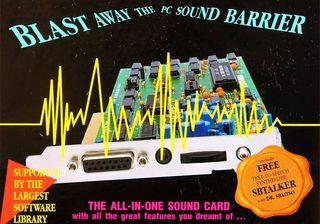Author of Sound Blaster: The Official Book talks about the early days of PC audio

Rich Heimlich is a big name in parts of the gaming industry. He created the first ever QA company Top Star, authored "Sound Blaster: The Official Book", and also happens to be the voice of the first ever sports announcer in a PC game. The folks creating Beep: A Documentary History of Game Sound recently interviewed Heimlich about the early days of PC game audio, and how Creative's Sound Blaster card became as big as it did.
We've got some highlights below, but the full video is worth a watch for a journey through the early days of PC sound.
In the 1980s, consumers had to be sold hard on PC audio. In those days, most PCs only had three expansion slots, and gamers would need to use those slots for things like hard drives, extra memory, and the like. A sound card would take up valuable real estate. AdLib was the first company to get their sound card out into the mainstream. They soon had competition from Creative Labs, and the story of how Creative forced AdLib out of the industry was an interesting one.
Creative was working on something called the Killer Card, which Rich Heimlich was stunned by when he first saw it in action. Heimlich says that the reason Creative's Killer (later rebranded Sound Blaster) was so much better than what AdLib had to offer was not because it used digital sound (the most widely cited reason). It was over two years before developers started using the digital sound to its full potential. Instead, it was because it was cheaper, and had more usable features, including a gameport built in so you could plug in a controller. This saved that all important expansion slot space.
Creative took over the industry within a year, and AdLib had to fight back. They started working on the AdLib Gold. However a Yamaha-created chip for that card continually failed to pass testing. Heimlich found out why this was from Creative. Both companies were using Yamaha parts, and since Creative was Yamaha's biggest customer at the time, they were basically calling the shots. Creative made sure that AdLib's chip wouldn't pass testing, because they knew whoever got to market with their new sound card first would win.
The Sound Blaster 16 came out first, and without competition, took over the market once again. Unsurprisingly, AdLib's chip passed testing shortly after, but by that time, the game was already won. AdLib Gold did not sell well, and the company filed for bankruptcy in 1992.
The biggest gaming news, reviews and hardware deals
Keep up to date with the most important stories and the best deals, as picked by the PC Gamer team.
Most Popular





